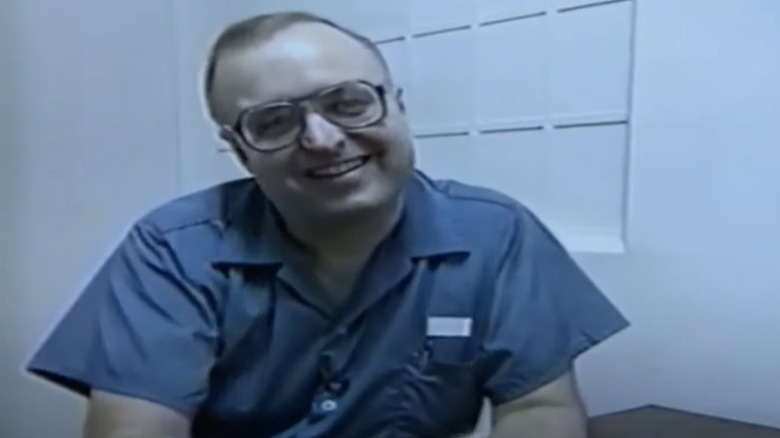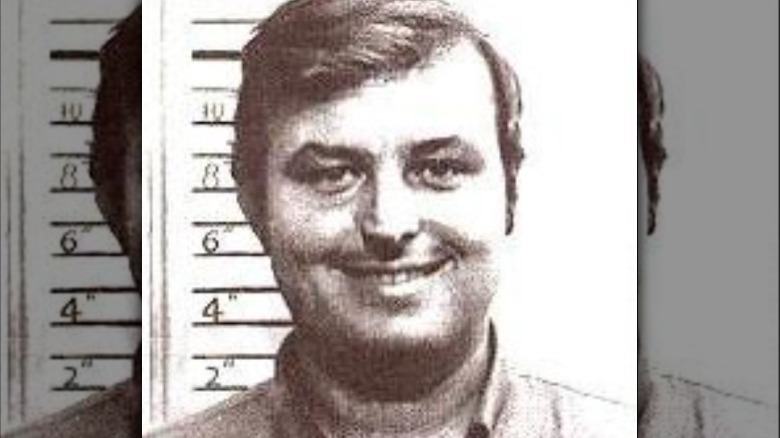Gerard John Schaefer May Have Had Even More Victims Than We Thought
Gerard John Schaefer isn't a household name. Other 1970s serial killers perpetually fascinate the public, like John Wane Gacy with 33 victims, or Ted Bundy with at least 14. Perhaps the world of true crime fixates on confirmed kills, and Schaefer's lack of notoriety is due to a single-digit murder tally. But many speculate the full extent of his crimes is vast. Until the next discovery, a menacing plus sign dangles after Schaefer's suspected count of 2 to 9 victims (via Murderpedia).
Law enforcement agents are all too familiar with Schaefer. "If I had a list of top five, which would include all of the serial killers I have interviewed throughout the country, he would definitely be in the top five," divulged former FBI agent Bill Hagerty (via the South Florida Sun Sentinel). Once a member of Florida law enforcement, Schaefer decided to join the ranks of American serial killers and now goes by the moniker "The Killer Cop."
After his 1973 conviction for slaying two women, Schaefer alternated from suing reporters for slanderously branding him a serial killer to confessions of exorbitant death tolls. "In 1973 I sat down and drew up a list of my own," explained Schaefer in a letter to his prison girlfriend (via "The Encyclopedia of Serial Killers" by Michael Newton). "As I recall, my list was just over 80." The truth is due to a lack of motivated authorities, we might never uncover how many of the hitchhikers Schaefer picked up went missing.
Two of his targets escaped
We might never know Gerard John Schaefer's tally, but unlike other killers, we're afforded a rare insight into the fate of his victims. Two brave survivors, Pamela Wells and Nancy Trotter, were abducted and miraculously escaped Schaefer (via Murderpedia). Luring the teens with a free ride to a local Florida beach, Schaefer instead drove them to a densely wooded swamp.
As if deriving pleasure from their fear, Schaefer began making accusations and threatening violence (via Palm Beach Post). He separated the girls, while instilling the threat that if one escaped, the other would suffer. While gagged, arms and legs tied, Trotter was instructed to stand on the tall exposed roots of a mangrove tree. Placing a noose around her young neck ensured a single slip would lead to an agonizing asphyxiation. Luckily for them both, Schaefer was sloppy. When left alone, they immediately wriggled free and escaped. Ropes still holding her wrists, she trudged through a mosquito-infested river, eventually emerging onto a road screaming until the first car stopped. Schaefer had provided his full name, perhaps confident the pair wouldn't live to reveal it.
After granting him months of bond, a Florida judge called Schaefer a "thoughtless fool" for his crimes (per Murderpedia). Then Schaefer was given two months of freedom before beginning a paltry sentence. This allowed Schaefer morbid opportunities. While on bond, he murdered Susan Place and Georgia Jessup, 6 miles from where Trotter and Wells were taken.
A disturbing collection
In 1973, a shocking collection of evidence was discovered in the home Gerard John Schaefer shared with his mother. The disturbing items suggested a long history of violence (via Murderpedia). Jewelry, personal effects, identification cards, and the teeth of numerous females were discovered as well as newspaper clippings about missing women, including one named Carmen Hallock. Also in the cursed collection were at least 30 Polaroids of women being tortured in ways eerily similar to the acts inflicted on the two escapees, Pamela Wells and Nancy Trotter.
There were pages upon pages of Schaefer's homemade torture erotica. A number of the story's supposedly fictional details resembled the names and descriptions of missing women. The state of Florida offered his horrific prose of torture and murder as evidence of his pathology (via Thought Catalog). One story appears to explain why Schaefer would take two female victims at once, or "doing doubles," as he would call it (via Deviant Behavior). In a short story, a deputy sheriff kills one girl in front of her friend — so he can witness the other girl's fear (via The Big Thrill).
According to Forensic, the "teeth and sections of bone" identified in Schaefer's collection belonged "to at least eight young women and girls." Still, in a move that ensured Schaefer's body count stayed low, it would be another 20 years before cops investigated the likely crimes.
Investigative oversight
Gerard John Schaefer is suspected of murders in Florida, West Virginia, Michigan, and Pennsylvania (via the South Florida Sun Sentinel). Twenty years after his incarceration, an investigation began for the murder of three Fort Lauderdale females: Carmen Marie Hallock, Leigh Bondadies Hainline, and Belinda Hutchins. It could be described as a gross oversight by officials that these cases weren't investigated sooner. Both Hallock and Hutchins had romantic relationships with Schaefer, and in an undeniable association, Hallock's teeth had been found in Schaefer's mother's house.
The identification cards of two missing Iowa girls — Collette Marie Goodenough and Barbara Ann Wilcox — failed to motivate an investigation. While hitchhiking through Schaefer's old sheriff deputy stomping grounds during his pre-jail sabbatical, the girls went missing. When their skeletal remains were found in 1977, the police couldn't determine a cause of death, so no charges were filed. There are also the deaths of Mary Briscolina and Elsie Farmer, whose bodies were found in 1973, their teeth pulled.
How do the police and state attorneys explain the lack of investigation? "Without some other evidence linking Schaefer to those girls, the law wouldn't allow that leap of assumption," said state attorney Philip Shailer, who served during the lackluster investigation of these women's deaths (per the South Florida Sun Sentinel). "Ultimately, he got what he should have," Shailer said of Schaefer's jailhouse death, perhaps believing this completed his job or provided closure to the families of those who donated teeth to Schaefer's collection.
Time in prison
Gerard John Schaefer went to jail for killing Susan Place and Georgia Jessup but avoided the death penalty like so many other 70s serial killers. But Schaefer just couldn't help but kill more people while in prison, this time vicariously. Schaefer would frequently offer to assist fellow inmates with their appeals or other legal problems, but the information they shared did not remain confidential (via "Killer Cop" by Sondra London). In one case, an inmate fighting a murder charge came to Schaefer for assistance. During their discussions, Schaefer won the inmate's trust and was told the location of the victim's body. When Schaefer passed this information on to the prosecution, his "client" got the death penalty.
This type of betrayal doesn't remain secret for long in prison. Soon, Schaefer became known as an informant. Schaefer was now a member of three unpopular prison groups: an ex-cop, a kid killer, and an informant. According to "Killer Cop," a prison insider described him as "running scared" and "looking over his shoulder." Schaefer's cell was set on fire twice, and he was consistently splashed with the most disgusting material prisoners could produce.
It's unknown why fellow prisoner Vincent Rivera stabbed and killed Schaefer with an overkill of 40 stab wounds (via "Serial Killer: Gerard Schaefer (The Killer Cop)." Explanations range from an argument over the last cup of hot water for coffee to a dispute over a monetary debt.
Evidence of other victims
We might never know how many slain women litter the path of this vicious killer. As recently as June 2022, new evidence surfaced which might link Schaefer to a 48-year-old cold case (via KIRO 7).
In June 1974, the skeletal remains of "Singer Island Jane Doe” were discovered near the waters of Palm Beach County, Florida. The local sheriff's office failed to make a connection between the missing girl and the local kid-killing cop (via The Washington Post). The erosion of evidence and lack of ID stymied investigation before it began. Now, thanks to DNA analysis technology, those remains were identified as Susan Gale Poole. Poole's purse was left on a friend's couch before she went missing in December 1972. Schaefer was out on bail for his abduction of Pamela Wells and Nancy Trotter. Per The Washington Post, current detective William Springer says, "Schaefer is the best suspect." Springer noted that Shaefer's "M.O. was to pick up young girls hitchhiking," and the body's location "tied up in the mangroves" fits his known crimes. If Poole's had her purse the day she went missing, perhaps it would have found its way into Schaefer's collection.





